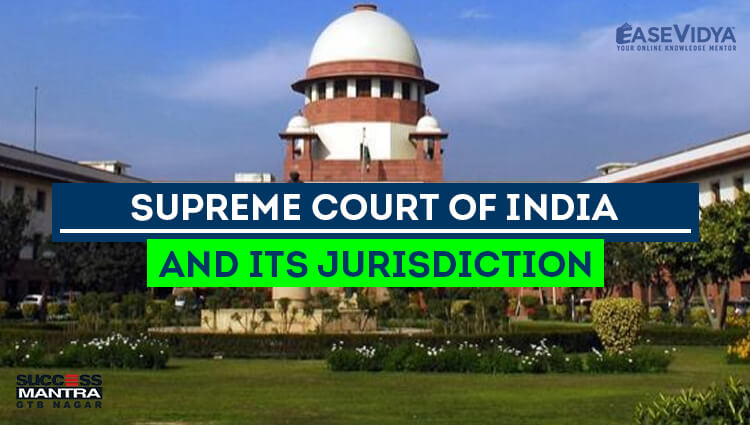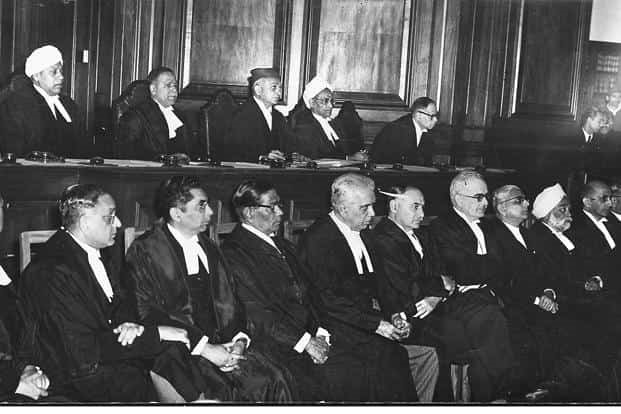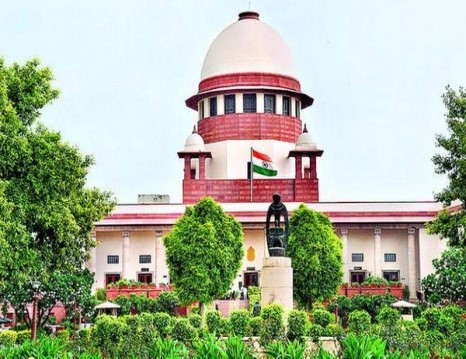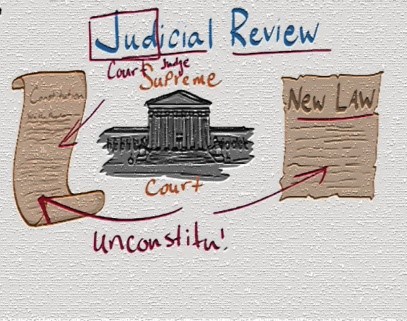
SUPREME COURT OF INDIA AND ITS JURISDICTION
SUPREME COURT OF INDIA & ITS JURISDICTION
The Supreme Court of India is the highest judicial court and the final court of appeal under the Constitution of India, the highest constitutional court, with the power of judicial review. India is a federal State and has a single and unified judicial system with three tier structure, i.e. Supreme Court, High Courts and Subordinate Courts.
HISTORICAL BACKGROUND OF SC OF INDIA

The promulgation of the Regulating Act of 1773 established the Supreme Court of Judicature at Calcutta as a Court of Record, with full power & authority. It was established to hear and determine all complaints for any crimes and also to entertain, hear and determine any suits or actions in Bengal, Bihar and Orissa. The Supreme Courts at Madras and Bombay was established by King George – III in 1800 and 1823 respectively. The India High Courts Act 1861 created High Courts for various provinces and abolished Supreme Courts at Calcutta, Madras and Bombay. These High Courts had the distinction of being the highest Courts for all cases till the creation of Federal Court of India under the Government of India Act 1935. After India attained independence in 1947, the Constitution of India came into being on 26 January 1950 and replaced Federal Court of India and the Judicial Committee of the Privy Council which were then at the apex of the Indian court system. In place the Supreme Court of India came into existence and its first sitting was held on 28 January 1950. The law declared by the Supreme Court is binding on all Courts within the territory of India.
CONSTITUTIONAL PROVISIONS RELATED TO SC IN INDIA
The Indian constitution provides for a provision of the Supreme Court under Part V (The Union) and Chapter 6 (The Union Judiciary). Articles from 124 to 147 in Part V of the Constitution deal with the organization, independence, jurisdiction, powers and procedures of the Supreme Court. Article 124 says that There shall be a Supreme Court of India which currently consists of a Chief Justice of India and 30 other judges of SC & Every Judge of the Supreme Court shall be appointed by the President by warrant under his hand and seal after consultation with such of the Judges of the Supreme Court and of the High Courts in the States as the President may deem necessary for the purpose. A Judge of the Supreme Court shall be removed from his office by an order of the President passed after an address by each House of Parliament supported by a majority of the total membership of that House and by a majority of not less than two - thirds of the members of that House present and voting has been presented to the President in the same session for such removal on the ground of proved misbehavior or incapacity. A person shall not be qualified for appointment as a Judge of the Supreme Court unless he is a citizen of India and —
• Has been for at least five years a Judge of a High Court or of two or more such Courts in succession.
• Has been for at least ten years an advocate of a High Court or of two or more such Courts in succession
• Is, in the opinion of the President, a distinguished jurist.

JURISDICTIONS OF THE SUPREME COURT
ORIGINAL JURISDICTION (ARTICLE 131)
As a Federal court, the Supreme Court decides disputes between different units of the Indian Federation. More elaborately, any dispute between:
• Centre and one or more states; or
• Centre and any state or states on one side and one or more states on the other; or
• Between two or more states.
In the above federal disputes, the Supreme Court has exclusive original jurisdiction.
WRIT JURISDICTION (ARTICLE 32)
The Supreme Court is empowered to issue writs, including habeas corpus, mandamus, prohibition, quo-warranto and certiorari for the enforcement of the fundamental rights of an aggrieved citizen. In this regard, the Supreme Court has original jurisdiction in the sense that an aggrieved citizen can go directly to the Supreme Court, not necessarily by way of appeal. However, the writ jurisdiction of the Supreme Court is not exclusive. The High Courts are also empowered to issue writs for the enforcement of the Fundamental Rights.
APPELLATE JURISDICTION (ARTICLE 132, 133, 134)
The Supreme Court is primarily a court of appeal and hears appeals against the judgments of the lower courts. It enjoys a wide appellate jurisdiction which can be classified under four heads:
• Appeals in constitutional matters
• Appeals in civil matters
• Appeals in criminal matters
• Appeals by special leave
ADVISORY JURISDICTION
The Constitution under Article 143 authorizes the President to seek the opinion of the Supreme Court in the two categories of matters:
• On any question of law or fact of public importance which has arisen or which is likely to arise.
• On any dispute arising out of any pre-constitution treaty, agreement, covenant, engagement and other similar instruments.
OTHER POWERS OF SUPREME COURT
Power to punish for contempt (civil or criminal) of court with simple imprisonment for 6 months or fine up to 2000. Civil contempt means willful disobedience to any judgment. Criminal contempt means doing any act which lowers the authority of the court or causing interference in judicial proceedings. Judicial review is also one of the powers of the SC to examine the constitutionality of legislative enactments and executive orders. The grounds of review is limited by- Parliamentary legislation or rules made by the Supreme Court.
Appointment of ad hoc judges-Art 127 states that if at any time there is lack of quorum of Judges of Supreme Court, the CJI may with the previous consent of the President and Chief Justice of High Court concerned request in writing the attendance of Judge of High Court duly qualified to be appointed as Judge of SC.
Appointment of retired judges of Supreme Court or High court - Art 128- The CJI at any time with the previous consent of the President and the person to be so appointed can appoint any person who had previously held the office of a Judge of SC.
Appointment of acting Chief Justice- Art 126- when the office of CJI is vacant or when the Chief Justice is by reason of absence or otherwise unable to perform duties of the office, the President in such case can appoint the Judge of the court to discharge the duties of the office.
Revisory Jurisdiction: The Supreme Court under Art. 137 is empowered to review any judgment or order made by it with a view to removing any mistake or error that might have crept in the judgement or order.

QUESTION (1-10)
Q.1 From which source India got the concept of Single order of court?
A. Government of India Act, 1935: ANSWER
B. Government of India Act, 1919
C. Pitts India Act, 1773
D. None of the following
Q.2 Which of the following Articles talks about the establishment of the Supreme Court?
A. Article 176
B. Article 153
C. Article 124: ANSWER
D. Article 324
Q.3 Which of the following statements is/are not true about India's Supreme Court?
A. Article 124 to 147 and Part V of the Indian Constitution informs about the composition and powers of the Supreme Court?
B. The Supreme Court was inaugurated on January 28, 1950
C. At present, there are 35 judges in the Supreme Court: ANSWER
D. Judges of Supreme Court are appointed by the President of India
Q.4 Which qualification is wrong for being a judge in the Supreme Court?
A. It is compulsory to be a citizen of India.
B. He should be a respected jurist in the eyes of Parliament: ANSWER
C. Must be a judge in the High Court for at least 5 years
D. He should be a lawyer in the High Court for at least 10 years
Q.5 Which statement regarding the tenure of judges of the Supreme Court is not correct?
A. Judge of the Supreme Court can remain in office till the age of 65 years.
B. Judge of the Supreme Court gives his resignation letter to the Chief Justice: ANSWER
C. On the recommendation of Parliament, he can be removed by the President.
D. Supreme Court judge can be removed only in the condition of misconduct
Q.6 Who can remove the Judge of the Supreme Court?
A. Chief Justice of the Supreme Court
B. Only President
C. Only Parliament
D. Both Parliament and President: ANSWER
Q.7 Which of the following statements is/are true?
A. Article 143 deals with Presidential reference to the Supreme Court.
B. Advice given by the Supreme Court under article 143 is not binding on the President.
C. The Supreme Court cannot punish for contempt of tribunals.
D. Both 1 & 2: ANSWER
Q.8 Who among the following has the right to establish the bench of Supreme Court elsewhere in the country?
A. The Chief Justice of India
B. The President of India
C. The Parliament
D. CJI with prior approval of the President: ANSWER
Q.9 Which of the following Article talks about the Original Jurisdiction of the Supreme Court of India?
A. Article 143
B. Article 136
C. Article 131: ANSWER
D. Article 130
Q.10 The Supreme Court of India has a wide appellate jurisdiction which defines supreme court as a court of appeal. Which of the following is the matter in which appellate jurisdiction is not available?
A. Appeals in constitutional matters
B. Appeals in civil matters
C. Appeals in criminal matters
D. None of the above: ANSWER












hqncxmllmj
Latest News on Education & LAW Exams Blogs | Success Mantra <a href="http://www.g39uus1nn2w3rlq9p55401qt6dy8354es.org/">ahqncxmllmj</a> [url=http://www.g39uus1nn2w3rlq9p55401qt6dy8354es.org/]uhqncxmllmj[/url] hqncxmllmj http://www.g39uus1nn2w3rlq9p55401qt6dy8354es.org/
bpyqdlwhr
Latest News on Education & LAW Exams Blogs | Success Mantra [url=http://www.g93syjqa255s7g93v5bgl386i4xw4k08s.org/]ubpyqdlwhr[/url] <a href="http://www.g93syjqa255s7g93v5bgl386i4xw4k08s.org/">abpyqdlwhr</a> bpyqdlwhr http://www.g93syjqa255s7g93v5bgl386i4xw4k08s.org/